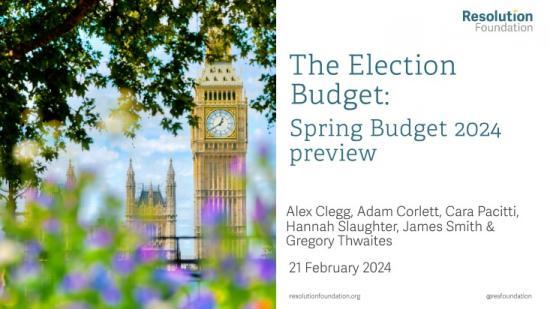Election Year Tax Cuts Are Sandwiched Between £20 Billion Of Tax Rises Already Implemented And £17 Billion Planned For After Polling Day
22nd February 2024

Lower interest rates will slightly increase the Chancellor's fiscal headroom for election year tax cuts, but these will be sandwiched between far bigger past and future tax rises, according to new Resolution Foundation research published on Wednesday 21 February 2024.
The Foundation's Spring Budget 2024 preview examines how the Office for Budget Responsibility might update its economic and fiscal outlook ahead of the Budget on 6 March, what this could mean for the size and shape of new tax cuts, and how these would fit into the government's wider tax and spend plans.
The Foundation notes that falling interest rates are set to be the key driver of lower borrowing and increase the size of the fiscal headroom against the government's ‘falling debt' fiscal rule from £13 billion to £23 billion.
The Foundation notes that £23 billion would be below the average level of headroom that Chancellors have had since 2010. Despite this, with a General Election looming, both the Prime Minister and Chancellor have hinted heavily that the bulk of it will be spent on tax cuts.
The planned 5p increase to fuel duty planned for 23rd March will be scrapped or postponed at a cost of £2 billion next year, while cutting the basic rate of Income Tax by 1p or cancelling the Personal Allowance freeze in 2024-25 would both cost £7 billion each. A cheaper option would be cutting employee National Insurance again by 1p, at a cost of £5 billion. Other options include raising the Child Benefit withdrawal threshold from £50,000 to £70,000 (costing £2 billion) or abolishing it altogether (costing £4 billion).
The Foundation notes that cutting the basic rate of Income Tax by 1p while maintaining the personal allowance freeze next year would mean anyone earning less than £38,000 would see their personal tax bills rise rather than fall.
Should the Chancellor announce £10 billion of tax cuts in his upcoming Budget, this would see £9 billion of net tax cuts introduced during the election year (including the £10 billion National Insurance cut that came into effect in January, but also threshold freezes).
But Britain is really being offered a ‘tax sandwich’, with these tax cuts sitting between significant past and future tax rises. Tax rises of around £20 billion were introduced in 2023-24, including freezing personal tax thresholds and increasing Corporation Tax.
Highly unusually, the government has also pre-announced major tax rises for after the next election, with a further £17 billion of tax rises set to come into effect in the next parliament, including a Spring 2025 Stamp Duty rise and three extra years of tax threshold freezes. History, and significant spending cuts pencilled in for after the election, tell us that further tax rises may well be announced after polling day - as we saw in 1993, 1998, 2011, 2016 and 2020.
The Foundation cautions that the idea that fresh tax cuts are affordable rests on ‘fiscal fictions’, for example that high inflation and a much bigger population will not lead to additional public service spending.
The biggest fiscal fiction is that post-election plans for day-to-day public service spending to rise by just 1 per cent in real terms will be delivered. Given protections for the NHS, defence and education, that would require real per-capita spending cuts of around 17 per cent for unprotected departments like the home office, justice and local government by 2028-29.
Avoiding those cuts would require £30 billion of extra spending, while media speculation that further headroom for tax cuts could be generated by further cutting spending growth from around 1 to 0.75 per cent would mean some public services having their spending power cut by around a fifth over the next parliament.
James Smith, Research Director at the Resolution Foundation, said:
"The Chancellor may see some small improvements to the outlook for the public finances ahead of his March Budget. He and the Prime Minister have made it clear they’ll spend any improvement on pre-election tax cuts.
"But what Britain is being offered is really a ‘tax sandwich’. Juicy tax cuts in this election year are sandwiched between far bigger tax rises already introduced last year. And highly unusually the government has already announced plans for a chunky package of tax rises that will come into effect after polling day.
"History also tells us those future tax rises will be even bigger, as governments tend to hike taxes early in a new parliament. Implausibly large cuts to public services that are pencilled in for after the election mean history may well be about to repeat itself."
See a collection of slides in the report HERE
